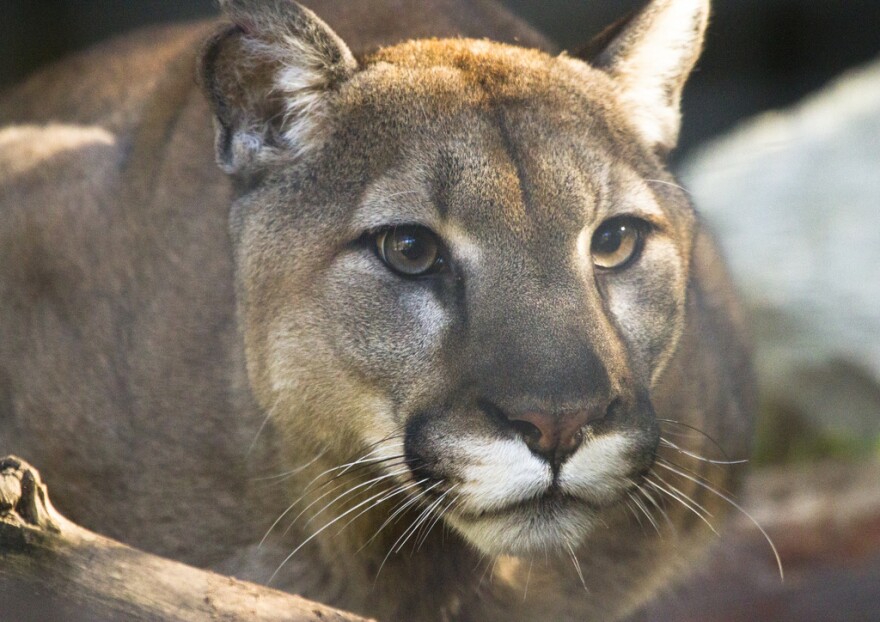A mother black bear and her two cubs were spotted earlier this week, on the border of Fayette and Clayton Counties, in northeast Iowa. The next day, a beekeeper discovered bear scat and paw prints near some damaged hives.
Also this week, the Iowa Department of Natural Resources confirmed the state's first mountain lion of 2014. A deer carcass with signs of mountain lion predation was found in Cherokee County, in northeast Iowa.
For the first time in five or six generations Iowans are coming face-to-face with large predators. For both black bears and mountain lions, young males are traveling far distances in search of mates.
These wild encounters have delighted some Iowans, while scaring or angering others.
Karl Hendriskson lives on a small farm, surrounded by woods near Decorah, in northeast Iowa. This May, he found a black bear in his front yard clinging to an evergreen, about 7 or 8 ft. in the air.
“I couldn’t believe what I was seeing…I thought it was a black lab puppy or dog up in the tree because of the snout...He turned to look at me, and I said, ‘It’s a black bear!’ So I quickly, quickly got out of here.”

Neighbors of Hendrickson’s found a pile of bear scat in their driveway and an emptied bird feeder. Bird and livestock feed left unattended attracts bears thanks to their strong sense of smell.
Iowa’s black bear population is trickling down from Wisconsin and Minnesota. The bear roaming Hendrickson’s neighborhood was likely a young male driven south into Iowa by older bears, wanting to protect their territories.
Iowa State University wildlife extension biologist Rebecca Christoffel says like black bears, young, male mountain lions are chased out of territories by older, dominate cats.
“Think of yourself of as child, right about at 17 or 18," Christoffel says. "Mom and dad are saying the same things, ‘Hey, time to fledge, get out of here.’”
Since mountain lions range throughout North and South America, cats will travel far distances. In 2011, a mountain young male from South Dakota was killed after colliding with a car in Connecticut.
With both predators, females more tolerated and therefore less likely to venture into Iowa. The cubs in eastern Iowa maybe the first black bears born in the state since the mid 1800s.
150 years ago, hunters collected bounties on large predators and this caused populations to shrink dramatically.
“Every time an animal came into an area, it was worth more dead than alive," says Christoffel. "Now we no longer have bounties paid on these animals…and state agencies are going out of their way to help animals recover.”


Today, states like Minnesota and South Dakota regulate the number of large predators killed through hunting seasons, which partially accounts for the population growth.
Iowa has no limits on the number of black bears and mountain lions that can be killed. This in part is because by the time the state legislature established hunting seasons, there were no black bears or mountain lions left.
Additionally, black bears and especially mountain lions were never very common in Iowa.
“We simply never had a lot of really good habitat for them,” Cristoffel says.
Most black bears and mountain lions spotted in Iowa are just traveling through, on a kind of road trip looking for girlfriends.
Christoffel says migration is good for the genetic diversity of a species. “Individuals from one population (move) and they’ll start breeding with individuals with another population, and that’s how you keep these populations going.”
Some Iowans like Hendrickson and his family are excited large predators are coming to Iowa, but others see these animals as a nuisance and a danger.
Iowa DNR biologist Vince Evelsizer says it’s good to be cautious and encourages Iowans to contact him with concerns and questions. He adds at most five mountain lions and about that many black bears live in Iowa.
Evelsizer says the public is less accepting of mountain lions than black bears. This in part is because mountain lions are more inclined to hunt livestock.
The Iowa DNR's only confirmed mountain lion sightings are of young males, meaning mountain lions are not breeding within the state. Usually the large cats originate from Nebraska and South Dakota, if not farther west.
Larry Ehret keeps about 65 head of cattle at his ranch in central Iowa. Back in May one of his calves disappeared.
“The only sign of it we found, was a tail down by the creek,” Ehret says. He thinks the fact the calf had an injured leg made it an easy meal for a mountain lion.

“The only thing I could surmise is that it was a mountain lion or a big predator, coyotes would have killed an animal and eaten it there," Ehret says. "It had to be something strong enough to take it over a fence; this calf probably weighed 600 lbs.”
Ehret estimates the lost calf cost him roughly $1,400 dollars. To be clear he isn’t 100-percent certain what took his animal; however, there have been mountain lion sightings near Ehret's ranch, and if he sees one, he intends to kill it.
Evelsizer says Iowa is at an impasse on whether this is a good idea.
“It’s definitely a grey issue," Evelsizer says. "I think the more you understand the topic and the animal’s biology, and their traits, I think that would go a long way in easing some fears.”

In the meantime, ISU's Rebecca Christoffel says there are a number of strategies to keep predators at a safe distance. "You want to right away get on it, so they don't get the idea that they are welcomed to help themselves."
She recommends not leaving food outside (and removing bird feeders and salt blocks,) putting up fencing, and getting a guard dog, or even a guard llama.
Both Christoffel and Evelsizer agree though it might take some adjustment, it's possible for Iowans to live safely and peacefully near wild predators.



